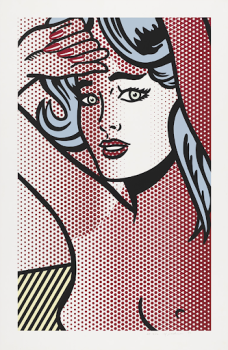
"The 'Nudes' series represents Lichtenstein at his most sophisticated, combining his pop sensibility with classical poses that recall both Titian and Ingres. The tension between high art traditions and commercial printing techniques reaches its apex in these works."
Nudes and Icons: Roy Lichtenstein's Most Cherished Works
Of the works in the Nudes series, Nude with Blue Hair is perhaps the most intimate and introspective. Gazing directly towards the viewer, the comic heroine inhabits almost the entirety of the picture plane in a cinematic, Hitchcockian guise, her chest just exposed and arms outstretched above her. The immediacy of the image is underscored by the rich figure-ground relationship achieved using varying sizes of Benday dots which overlap several objects at a time, rather than be restricted within the boundaries of a certain object or outline, as was the case in Lichtenstien’s previous work. Describing the technique, Lichtenstein noted, “It’s a little bit the way chiaroscuro isn’t just shadows but a way of combining the figure and background, or whatever’s near it in a dark area… You’re not confined to the object pattern, but the subject matter excuse for this is that it’s a shadow. And that’s interesting to me.” (the artist quoted in: Exh. Cat., London, Anthony d’Offay Gallery, Some Kind of Reality: Roy Lichtenstein Interviewed by David Sylvester in 1966 and 1997, October - November 1997, p. 38) One of few works that Dorothy and Roy Lichtenstein retained for their personal collection, Nude with Blue Hair, alongside the other choice examples from their collection, provides a rare glimpse into Roy's process and artistic development. The very first time that these treasured works have been available on the public market, their presentation this fall represents a remarkable and unprecedented opportunity to acquire masterworks from pivotal moments in Roy's practice, and the works he and Dorothy cherished most.


"Lichtenstein's systematic approach to image-making—his careful calibration of dots, lines, and planes—represents not just a style but an epistemology of seeing. His work interrogates how mechanical reproduction mediates our experience of both art and reality."
Lichtenstein’s practice and the very style for which he is best known is embedded in the formal qualities of printmaking. It’s near impossible to separate the artist from the medium, his dotted fields referring to halftone screens, and his stripes reminiscent of linear hatchings. Lichtenstein’s first Pop subject appeared in Ten Dollar Bill, a lithograph executed in 1956, and since then, consumer imagery overwhelmed his compositions, from comic book and advertising images in the 1960s to art historical allusions in the 1970s and 80s. The artist often started conceptualizing each print with a pencil sketch, and later created more refined collages with a variety of printed and painted papers as the basis for the image matrix. Thus, each image was imbued with great sensitivity and focus while rendered in Lichtenstein’s distinctly bold visual language. It is this attention to detail which permeates Lichtenstein’s overall practice and exemplifies the seminal role prints played in the artist’s nearly four decades-long career.
With cornflower blue highlights and striking red nails, Nude with Blue Hair moves beyond self-reference and introduces stylistic ingenuity and an element of voyeurism with the overlapping qualities of Benday dots. As the dots glide across the figure’s body, the gradations of light and shadow mimic reflections across a lens, further manipulating the viewer’s concept of reality. As scholar Sheena Wagstaff describes, “Lichtenstein’s Nudes series, created in the last four years of his life, are a profoundly innovative and active meditation upon the relationship of creation and perception.” (Sheena Wagstaff, "Late Nudes," in Exh. Cat., Art Institute of Chicago (and traveling), Roy Lichtenstein: A Retrospective, May 2012 - May 2013, pp. 103-104) Nude with Blue Hair is no exception; at alluring proportions, the present work evokes Lichtenstein’s graphic sensibility while simultaneously illustrating his adept sophistication and mastery of the printmaking medium.


In 1993, Roy Lichtenstein embarked on his final print series with Tyler Graphics and unveiled images of the female nude for the very first time. Hailing from this iconic series of Nudes, Nude with Blue Hair represents a notable point in Lichtenstein’s late oeuvre: creating a greater undulation of light and space using subtler, more delicate tones and overlapping Benday dots. Based on “love” and “girl” comic book illustrations, the Nudes became a starting point for what would come to be Lichtenstein’s final paintings before the artist’s passing in 1997, such as Nude with Pyramid, in the collection of The Broad, Los Angeles, Nude at Vanity, in the collection of the San Francisco Museum of Modern Art, and Nude with Bust, the study for which is on offer this season. Nude with Blue Hair not only evinces Lichtenstein’s characteristic Pop aesthetic, but reveals the artist’s profound influence and accomplishment in the field of contemporary printmaking.



















